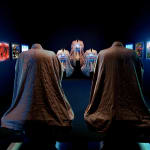
Sheba Chhachhi
Winged Pilgrims: A Chronicle from Asia, 2006/2008
8 animated duratrans lightboxes, two layers: 47 1/4 x 25 5/8 x 3 15/16 inches ( 120x 65 x 10 cm ) each
2 animated duratrans lightboxes, three layers:7- 7/8 x 25 5/8 x 3 15/16 inches ( 180 x 65 x 10 cm ) each
5 silk and fibreglass objects
5 motion lamps
sound: continuous looped
2 animated duratrans lightboxes, three layers:7- 7/8 x 25 5/8 x 3 15/16 inches ( 180 x 65 x 10 cm ) each
5 silk and fibreglass objects
5 motion lamps
sound: continuous looped
Darkened Room: 600 x 900 x 250cm (236 1/4 x 354 5/16 x 98 7/16 inches)
Further images
From the sixth century on, pilgrims, texts, mores, myths and artifacts travelled across Asia, creating a rich Asian cosmopolitanism. Today, mass-produced goods carry new forms of globalized culture. Winged Pilgrims:...
From the sixth century on, pilgrims, texts, mores, myths and artifacts travelled across Asia, creating a rich Asian cosmopolitanism. Today, mass-produced goods carry new forms of globalized culture. Winged Pilgrims: A Chronicle from Asia maps these migrations through three key elements that are simultaneously material and metaphoric: birds, the robes of pilgrims, and the ‘plasma action’ TV toy.
Simulacra par excellence, this popular Chinese-made toy presents one kind of contemporary iteration of ‘Nature’: fantasy landscapes where the high urban and a kitsch pastoral cohabit in bizarre harmony.
In 2005, panic surronding the spread of Avian/Asian flu to the west led to the killing of wild birds and attempts to control their migration. Millions of birds continue to be ‘culled’ although the spread is not pandemic yet. Ironically, it is Euro-American industrial food farming practices that have led to the H5N1 virus becoming pathogenic. Infection patterns from Asia to Europe follow supply chains of poultry trade rather than migratory patterns.
Masked and encapsulated in contamination suits, figures (ubiquitous today in the wake of the Covid pandemic) carrying dead wild birds flank the entry into the installation, appearing again in motion lamps held by empty pilgrim robes.
The figure of the pilgrim, deeply embedded in Asian culture, metastasizes into strange kinship with the faceless men in protective clothing. Historically, the pilgrim recorded exchanges between India and China. The empty robes evoke the pilgrim as a paradox – absent yet a witness, holding sacred texts as well as television sets.
A female voice, singing acappela, creates a specially composed sonic environment.
Animated lightboxes, adapted from the toy TV, encircle the space. Birds, both real and mythical, glide across imaginary palimpsests which weave together Asian landscape traditions.
Each lightbox offers a retooled fable: Garuda, mythical hybrid of human and eagle whose huge wingspan inspired the curves of the pagoda, meets a tenth-century. Song dynasty ink painting; the classical poem replaced with the Heart Sutra in Siddham script; peacocks flying in arid mountainscapes accompany the bird-necked lute along the Silk Route; travelling parrots, tellers of erotic tales, traverse a dense urbanscape; Hamsa the swan, believed in Indian thought to have the wisdom of discrimination, is glimpsed in a Japanese graveyard; the mythical firebird called Simurgh in Persia, Fenghua in China and Hoo hoo in Japan, heralding ressurection, has to ford polluted urban rivers, while in the ‘Conference of the Birds’, an assembly-line of battery hens advance over an allegorical ground fusing elements drawn from over eleven pre-modern painting traditions which honour the clear-sighted sagacity of birds.
Perhaps birds were the earliest form of global movement, pilgrims the first 'citizens of the world', and landscape traditions are emblematic of the relationship between humans and nature at any historical moment. This constellation offers a different sightline into globalization and its histories; one which traverses geographical and temporal terrains, and mediates between the simple and the hybrid, the human, the non-human and the inhuman, the mystical and the brutal, the material and the spiritual.
Simulacra par excellence, this popular Chinese-made toy presents one kind of contemporary iteration of ‘Nature’: fantasy landscapes where the high urban and a kitsch pastoral cohabit in bizarre harmony.
In 2005, panic surronding the spread of Avian/Asian flu to the west led to the killing of wild birds and attempts to control their migration. Millions of birds continue to be ‘culled’ although the spread is not pandemic yet. Ironically, it is Euro-American industrial food farming practices that have led to the H5N1 virus becoming pathogenic. Infection patterns from Asia to Europe follow supply chains of poultry trade rather than migratory patterns.
Masked and encapsulated in contamination suits, figures (ubiquitous today in the wake of the Covid pandemic) carrying dead wild birds flank the entry into the installation, appearing again in motion lamps held by empty pilgrim robes.
The figure of the pilgrim, deeply embedded in Asian culture, metastasizes into strange kinship with the faceless men in protective clothing. Historically, the pilgrim recorded exchanges between India and China. The empty robes evoke the pilgrim as a paradox – absent yet a witness, holding sacred texts as well as television sets.
A female voice, singing acappela, creates a specially composed sonic environment.
Animated lightboxes, adapted from the toy TV, encircle the space. Birds, both real and mythical, glide across imaginary palimpsests which weave together Asian landscape traditions.
Each lightbox offers a retooled fable: Garuda, mythical hybrid of human and eagle whose huge wingspan inspired the curves of the pagoda, meets a tenth-century. Song dynasty ink painting; the classical poem replaced with the Heart Sutra in Siddham script; peacocks flying in arid mountainscapes accompany the bird-necked lute along the Silk Route; travelling parrots, tellers of erotic tales, traverse a dense urbanscape; Hamsa the swan, believed in Indian thought to have the wisdom of discrimination, is glimpsed in a Japanese graveyard; the mythical firebird called Simurgh in Persia, Fenghua in China and Hoo hoo in Japan, heralding ressurection, has to ford polluted urban rivers, while in the ‘Conference of the Birds’, an assembly-line of battery hens advance over an allegorical ground fusing elements drawn from over eleven pre-modern painting traditions which honour the clear-sighted sagacity of birds.
Perhaps birds were the earliest form of global movement, pilgrims the first 'citizens of the world', and landscape traditions are emblematic of the relationship between humans and nature at any historical moment. This constellation offers a different sightline into globalization and its histories; one which traverses geographical and temporal terrains, and mediates between the simple and the hybrid, the human, the non-human and the inhuman, the mystical and the brutal, the material and the spiritual.

